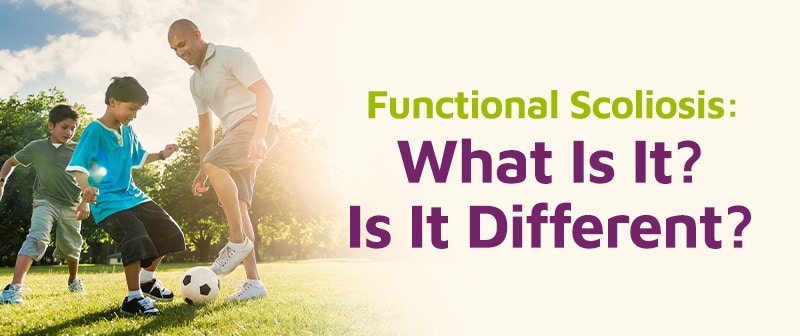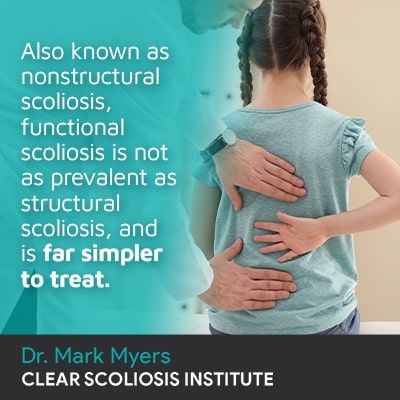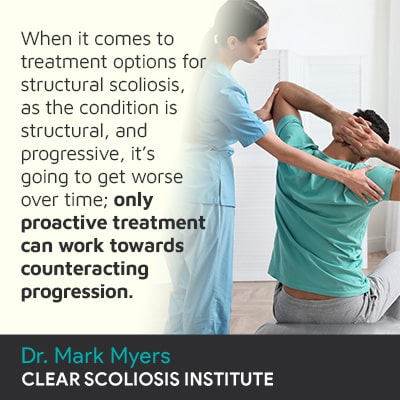
Functional scoliosis is considered a temporary condition with a temporary cause, such as poor posture, or a body irregularity. Patients with functional scoliosis can change their unnatural spinal curvature by changing the position of their body, which is why functional scoliosis isn’t complex to treat. Continue reading to learn about the differences between functional scoliosis and structural scoliosis.
Functional scoliosis means an unnatural sideways spinal curve is present, but it’s nonstructural, meaning there is no structural abnormality within the spine itself; functional scoliosis doesn’t have a rotational component, as does structural scoliosis, so is less complex to treat.
There are different types of scoliosis a person can develop, and functional scoliosis is not considered a true scoliosis because it doesn’t involve a rotational component.

While patients with functional scoliosis have an unnatural sideways spinal curve, there is no rotational component, meaning the spine doesn’t twist, in addition to bending unnaturally to the side, as it does with structural scoliosis.
So in cases of functional scoliosis, there is nothing abnormal about the spine’s actual structure.
When scoliosis is first diagnosed, it’s further classified based on specific key patient/condition variables, and one is condition type, determined by causation.
When it comes to functional scoliosis, the cause is temporary; it can be caused by chronic poor posture and/or a body irregularity that introduces uneven forces, such as leg-length discrepancy (LLD).
When the legs are different lengths, the lumbar spine (lower back) can curve unnaturally (functional scoliosis) as it attempts to counteract pelvic obliquity caused by the asymmetrical leg length; pelvic obliquity means the pelvis is misaligned, typically with one hip sitting higher than the other, which is caused by the effort to maintain shoulder balance.
If leg-length discrepancy goes untreated, over time, it can increase rates of natural age-related spinal degeneration, cause the development of an uneconomical gait, and varying levels of lower back pain.
When a condition is structural, there is no change in position that will alter it, but with functional scoliosis, if a person was to make an active effort to reposition their spine, they can do so; for example, bending forward or lying down can actually reduce, or eliminate, a functional scoliotic curve.
As is the case with all types of scoliosis, effective treatment has to be shaped around a condition’s underlying cause, and functional scoliosis is no exception.
While poor posture can seem like a minor issue, if not corrected, over time, it can cause back pain, joint degeneration, and spinal dysfunction by exposing the vertebrae (bones of the spine) to constant uneven pressure.
Unsupported postures disrupt the spine’s ability to absorb and distribute mechanical stress, can constrict the back’s blood vessels and nerves, and can strain the tissues and ligaments that surround the spine.
Poor posture can also lead to uneven muscle use and strain; it’s not just the spine that maintains its natural curves and alignment, but also its surrounding muscles.
When chronic poor posture is the cause, postural remodeling can address the issue, and there are exercises and stretches (physical therapy) that can help facilitate healthy posture that elongates the spine.
When a body irregularity like leg-length discrepancy is the cause, it can be addressed with custom orthotics and/or custom insoles that restore symmetrical leg length, stopping uneven pressure and load distribution on the spine, and restoring the spine’s natural curves/alignment.
So now that we’ve discussed functional scoliosis, including its treatment needs, let’s move on to the more common and complex form: structural scoliosis.
In order to reach a diagnosis of structural scoliosis, which is considered a true scoliosis, certain condition characteristics have to be present; an unnatural sideways spinal curve has developed, with rotation, and a minimum Cobb angle of 10 degrees.
The rotational component means that in addition to the spine bending unnaturally to the side, it also twists, making it a complex 3-dimensional condition.
A patient’s Cobb angle is measured during X-ray, and the higher the Cobb angle, the more out of alignment the spine is.
In addition, Cobb angle classifies conditions in terms of severity:
Mild scoliosis: Cobb angle measurement of between 10 and 25 degrees
Moderate scoliosis: Cobb angle measurement of between 25 and 40 degrees
Severe scoliosis: Cobb angle measurement of 40+ degrees
So the parameters of reaching a structural scoliosis diagnosis are different from those of functional scoliosis, and under the umbrella of structural scoliosis, there are more different types, each with its unique treatment needs: idiopathic, degenerative, neuromuscular, and congenital scoliosis.
Structural scoliosis is also progressive, meaning a scoliotic curve will increase in size, especially if left untreated, so the severity level that’s present at the time of diagnosis is not indicative of where the condition will stay.

Scoliosis introduces uneven forces and uneven pressure to the spine and body in general, which is why its effects can be felt throughout.
When it comes to treating scoliosis, there are different approaches that offer patients different potential outcomes.
While a traditional treatment approach values watching and waiting and a more reactive response to a scoliosis diagnosis, modern conservative treatment approaches a diagnosis differently and values being proactive with treatment.
There are never treatment guarantees, but early detection, when responded to with proactive treatment, does improve the likelihood of successful treatment; starting treatment early in a condition’s progressive line, before significant progression has occurred, means the spine is going to be more flexible and responsive to treatment.
Once a certain amount of progression has occurred, the spine’s level of flexibility is reduced, and this means not only will the spine be less responsive to chiropractic treatment, but certain therapeutic exercises, used in treatment, won’t be within the patient’s ability to perform.
In cases where the spine is overly rigid, as can happen in adult patients recently diagnosed, some preparatory work has to be done, prior to starting the regular course of treatment, to help establish a baseline level of spinal flexibility and range of motion.
When it comes to treating structural scoliosis, as a structural spinal condition, its main impact has to be on a structural level, and this is worked towards through scoliosis-specific chiropractic care.
As a CLEAR-certified scoliosis chiropractor, I favor a conservative chiropractic-centered treatment approach that uses a series of chiropractic techniques and precise manual adjustments to work towards repositioning the vertebrae at the curve’s apex.
The goal is to manipulate the position of the most-tilted vertebrae so they are better aligned with the rest of the spine.
Addressing areas of vertebral subluxation through chiropractic care can help restore as much of the spine’s natural curves as possible, improving its overall function and biomechanics.
A conservative approach also values integrating multiple treatment disciplines so conditions can be impacted on every level, and once I start to see structural results, I can focus on other areas such as muscle strength and imbalance.
By combining chiropractic care with a variety of physical therapies, I can also help patients work towards increasing core strength so the spine can receive optimal support from its surrounding muscles.
In addition, physical therapy and the prescription of scoliosis-specific exercises (SSEs) can help address any areas of muscle imbalance; certain scoliosis-specific exercises also help activate specific areas of the brain for improved brain-body communication that facilitates healthy posture and body positioning.
Corrective bracing is another treatment option that’s particularly effective on growing spines and facilitates corrective results by pushing the spine into a healthier position.
Rehabilitation is also important for further stabilizing the spine, and can involve a focus on custom-prescribed exercises to help patients establish a home-rehabilitation program.
When it comes to the main difference between functional and structural scoliosis, we’re talking about the structure of the spine itself, and while functional scoliosis doesn’t include a rotational component, structural scoliosis does.
In fact, functional scoliosis isn’t considered a true scoliosis because as it’s nonstructural, it can be easily addressed with changes to posture and/or addressing any body irregularities, such as leg-length discrepancy.
When chronic poor posture is the cause, physical therapy, exercises, and stretches that encourage healthy posture and elongate the spine can help realign the spine.
When a body irregularity like leg-length discrepancy is the cause, addressing the irregularity reduces the uneven forces being exposed to the spine; custom orthotics and/or insoles can restore leg symmetry and reduce/remove those uneven forces.
Treatment for structural scoliosis is far more complex as the condition has to be impacted, primarily, on a structural level.
Through chiropractic care, a curvature reduction can be worked towards, and when combined with physical therapy, increasing core strength so the spine’s surrounding muscles are strong and supportive is an important facet of conservative treatment.
When patients can benefit from bracing, corrective bracing can help augment corrective results by pushing the spine into a healthier position, and a series of home exercises can help to further stabilize the spine.
So if you have been recently diagnosed with functional scoliosis, some work will have to be done to improve posture and address any related body irregularities; for those recently diagnosed with structural scoliosis, treatment can be lengthy and intense, but that doesn’t mean improvements can’t be made, and the CLEAR Scoliosis Institute’s results speak for themselves.

CLEAR provides a unique and innovative way of understanding scoliosis. Sign up to receive facts and information you won’t find anywhere else.
